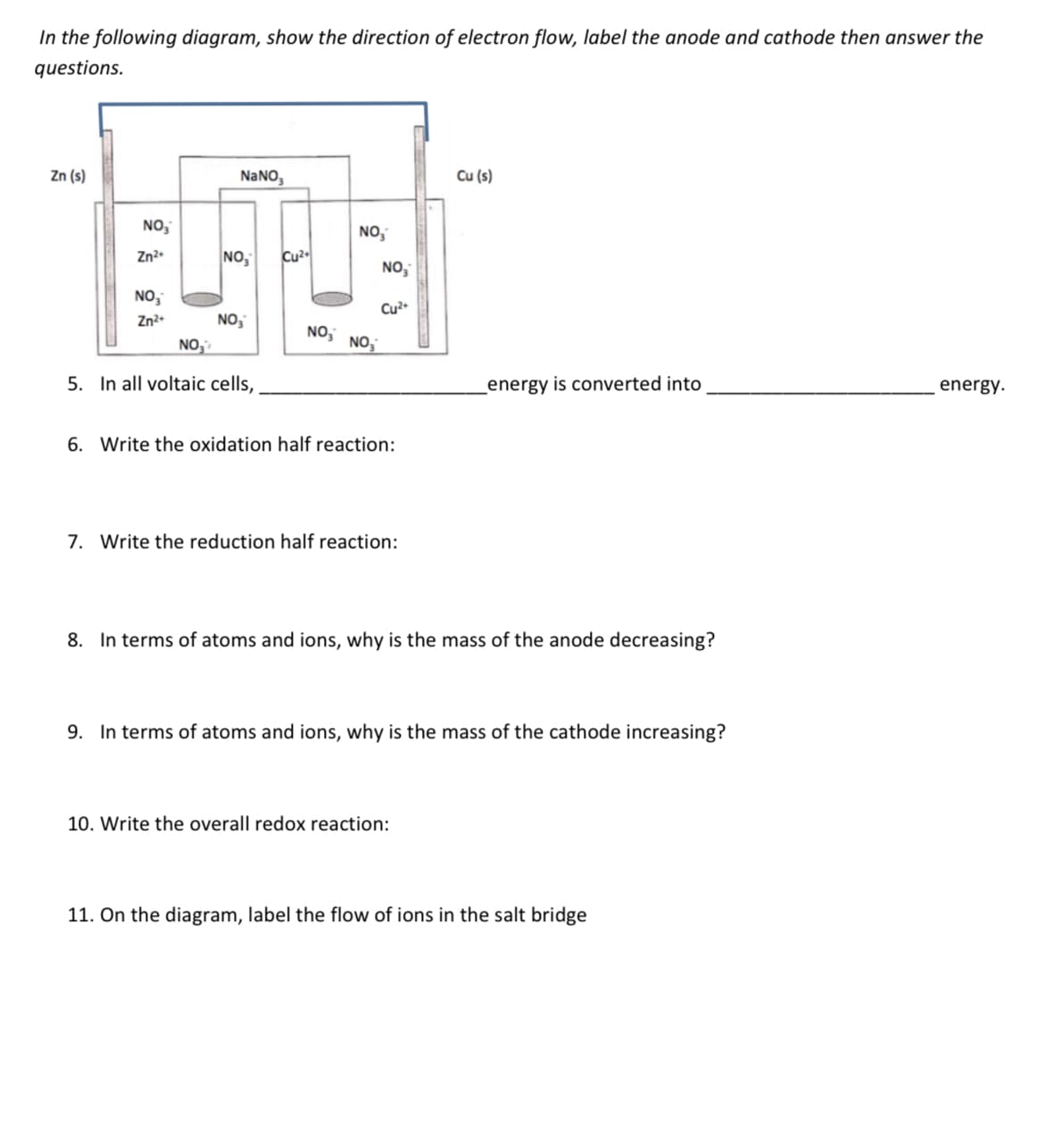In the following diagram, show the direction of electron flow, label the anode and cathode then answer the questions. Zn (s) NaNO, Cu (s) NO, NO, Zn2 NO, Cu2 NO, NO, Cu Zn2 NO, NO, NO, NO, 5. In all voltaic cells, energy is converted into energy. 6. Write the oxidation half reaction: 7. Write the reduction half reaction: 8. In terms of atoms and ions, why is the mass of the anode decreasing? 9. In terms of atoms and ions, why is the mass of the cathode increasing? 10. Write the overall redox reaction: 11. On the diagram, label the flow of ions in the salt bridge
In the following diagram, show the direction of electron flow, label the anode and cathode then answer the questions. Zn (s) NaNO, Cu (s) NO, NO, Zn2 NO, Cu2 NO, NO, Cu Zn2 NO, NO, NO, NO, 5. In all voltaic cells, energy is converted into energy. 6. Write the oxidation half reaction: 7. Write the reduction half reaction: 8. In terms of atoms and ions, why is the mass of the anode decreasing? 9. In terms of atoms and ions, why is the mass of the cathode increasing? 10. Write the overall redox reaction: 11. On the diagram, label the flow of ions in the salt bridge
General Chemistry - Standalone book (MindTap Course List)
11th Edition
ISBN:9781305580343
Author:Steven D. Gammon, Ebbing, Darrell Ebbing, Steven D., Darrell; Gammon, Darrell Ebbing; Steven D. Gammon, Darrell D.; Gammon, Ebbing; Steven D. Gammon; Darrell
Publisher:Steven D. Gammon, Ebbing, Darrell Ebbing, Steven D., Darrell; Gammon, Darrell Ebbing; Steven D. Gammon, Darrell D.; Gammon, Ebbing; Steven D. Gammon; Darrell
Chapter19: Electrochemistry
Section: Chapter Questions
Problem 19.48QP: A mercury battery, used for hearing aids and electric watches, delivers a constant voltage (1.35 V)...
Related questions
Question

Transcribed Image Text:In the following diagram, show the direction of electron flow, label the anode and cathode then answer the
questions.
Zn (s)
NANO,
Cu (s)
NO,
NO,
Zn2.
NO,
Cu2•
NO,
NO,
Cu²+
Zn2-
NO,
NO,
NO,
NO,
5. In all voltaic cells,
_energy is converted into
energy.
6. Write the oxidation half reaction:
7. Write the reduction half reaction:
8. In terms of atoms and ions, why is the mass of the anode decreasing?
9. In terms of atoms and ions, why is the mass of the cathode increasing?
10. Write the overall redox reaction:
11. On the diagram, label the flow of ions in the salt bridge
Expert Solution
This question has been solved!
Explore an expertly crafted, step-by-step solution for a thorough understanding of key concepts.
This is a popular solution!
Trending now
This is a popular solution!
Step by step
Solved in 5 steps with 5 images

Knowledge Booster
Learn more about
Need a deep-dive on the concept behind this application? Look no further. Learn more about this topic, chemistry and related others by exploring similar questions and additional content below.Recommended textbooks for you

General Chemistry - Standalone book (MindTap Cour…
Chemistry
ISBN:
9781305580343
Author:
Steven D. Gammon, Ebbing, Darrell Ebbing, Steven D., Darrell; Gammon, Darrell Ebbing; Steven D. Gammon, Darrell D.; Gammon, Ebbing; Steven D. Gammon; Darrell
Publisher:
Cengage Learning

Chemistry: The Molecular Science
Chemistry
ISBN:
9781285199047
Author:
John W. Moore, Conrad L. Stanitski
Publisher:
Cengage Learning

Chemistry for Engineering Students
Chemistry
ISBN:
9781337398909
Author:
Lawrence S. Brown, Tom Holme
Publisher:
Cengage Learning

General Chemistry - Standalone book (MindTap Cour…
Chemistry
ISBN:
9781305580343
Author:
Steven D. Gammon, Ebbing, Darrell Ebbing, Steven D., Darrell; Gammon, Darrell Ebbing; Steven D. Gammon, Darrell D.; Gammon, Ebbing; Steven D. Gammon; Darrell
Publisher:
Cengage Learning

Chemistry: The Molecular Science
Chemistry
ISBN:
9781285199047
Author:
John W. Moore, Conrad L. Stanitski
Publisher:
Cengage Learning

Chemistry for Engineering Students
Chemistry
ISBN:
9781337398909
Author:
Lawrence S. Brown, Tom Holme
Publisher:
Cengage Learning

Chemistry by OpenStax (2015-05-04)
Chemistry
ISBN:
9781938168390
Author:
Klaus Theopold, Richard H Langley, Paul Flowers, William R. Robinson, Mark Blaser
Publisher:
OpenStax

Chemistry & Chemical Reactivity
Chemistry
ISBN:
9781133949640
Author:
John C. Kotz, Paul M. Treichel, John Townsend, David Treichel
Publisher:
Cengage Learning

Chemistry & Chemical Reactivity
Chemistry
ISBN:
9781337399074
Author:
John C. Kotz, Paul M. Treichel, John Townsend, David Treichel
Publisher:
Cengage Learning